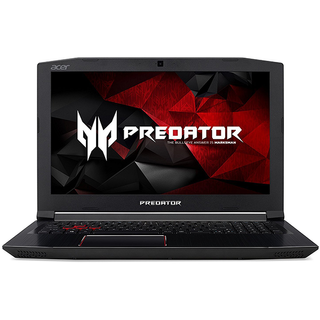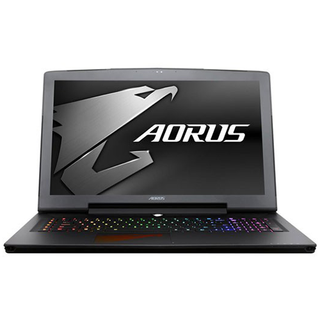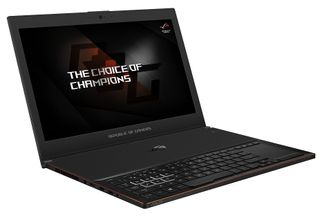Eurocom Q5 Max-Q Gaming Laptop Review
Why you can trust Tom's Hardware
Synthetic Benchmarks
The Eurocom Q5 is the second laptop we’ve tested with Nvidia’s Max-Q technology. It also comes with an Intel Core i7-7700HQ, a GTX 1070 with Max-Q Design, 16GB of DDR4-2400 memory, and a 512GB M.2 SSD. Its display is a Full HD (1920x1080) anti-glare TN panel with a 120Hz refresh rate. Measuring 0.74” thin and weighing 4.2lbs, the Eurocom Q5 is the thinnest and lightest GTX 1070-based laptop we've tested, thanks in no small part to Max-Q. Let’s hope that the thinner profile doesn’t impede its performance dramatically.
Now for the competition.
The best point of comparison is undoubtedly a full-fledged GTX 1070, so we’re including the recently reviewed MSI GE63VR Raider. It also features an i7-7700HQ, but comes with 32GB of DDR4-2400 memory, a 512GB M.2 SSD, and a 1TB 7200 RPM HDD. It has a FHD 120Hz matte display with a 3ms response time. We expect the Eurocom Q5 to provide at least 85% of the Raider's performance. The Raider is much thicker, and therefore has a more robust cooling system; if the Q5 falls down on controlling heat, that performance gap could be wider.
The second laptop in our comparison is the Asus ROG Zephyrus, which features a GTX 1080 with Max-Q Design. It contains an i7-7700HQ, 16GB of DDR4-2400 memory, and a 512GB M.2 SSD. Its display is a 15.6” FHD anti-glare IPS panel with G-Sync and a 120Hz refresh rate. As the first Max-Q laptop we tested, we were pleased to find that the Zephyrus delivered similar performance to a fully-fledged GTX 1080-based laptop. However, it lacked processing power, because GTX 1080-equipped laptops tend to use overclockable CPUs, and it suffered from thermal throttling in particularly demanding titles.
To fulfill the role of the traditional high-end gaming laptop, we’re throwing the Aorux X7 DT v7 into the mix. It’s equipped with an overclockable Core i7-7820HK, a GTX 1080, 16GB of DDR4-2400 memory, a 512GB M.2 SSD for the operating system, and a 1TB 7200RPM HDD for additional storage. The Aorus has a 17.3” display with a 5ms response time, a 120Hz refresh rate, and G-Sync, but it stands out because it’s one of the few gaming laptops on the market with Quad HD (2560x1440) resolution.
Finally, we’ve included the recently reviewed Acer Predator Helios 300, which we awarded with an Editor’s Choice for its excellent performance and low price. The GTX 1060-based Helios features an i7-7700HQ, 16GB of DDR4-2133 memory, and a 256GB M.2 SSD as its only storage source. It features a 15.6” FHD display. The Helios doesn’t have any extraneous features, which is part of its charm; it’s gaming value in its purest form.
3DMark



3DMark’s game-like workloads give us a sneak peak of our roundup’s gaming results.
The Eurocom Q5 slightly underperforms the MSI GE63VR Raider, which is to be expected. We see the Q5 fall behind the Raider across the board, but it doesn’t dip as low as the Acer Predator Helios 300. The charts create an almost perfect staircase effect, with the Max-Q GTX 1070 falling cleanly between the GTX 1060 and GTX 1070, and the Max-Q GTX 1080 between the GTX 1080 and GTX 1070.
Cinebench R15
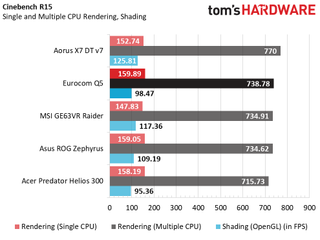
Cinebench measures CPU prowess, particularly the benchmark's single and multi-core tests. On the other hand, the OpenGL shading test is platform-based, with a slight preference for GPU strength.
Starting off with CPU-based benchmarks, the Q5 matches the Raider, Zephyrus, Helios, and even X7 in single core performance. However, the X7 takes the lead in multi-core performance thanks to its more robust i7-7820HK CPU. Things get interesting with OpenGL performance. The Q5 doesn’t perform as well as the Raider, as expected. But we also see the Zephyrus fall behind the Raider, despite the former’s GTX 1080.
CompuBench

CompuBench features a handful of benchmarks. We use the platform-based Video Processing test and GPU-based Bitcoin Mining test.
We witness a perfect staircase effect yet again, this time in both workloads. The Q5’s less powerful Max-Q GTX 1070 provides a two-point reduction compared to the Raider. It takes a more considerable hit in the Bitcoin Mining score (a 19% reduction).
IOMeter


We perform an IOmeter test on each laptop’s primary drive to measure basic random and sequential read and write speeds. Most of the laptops in this roundup contain Samsung SSDs: the Q5 has a 512GB 960 Pro, the Raider has a 512GB PM871, and the X7 and Zephyrus both have 512GB SM951s. The outlier is the Helios, which contains a 256GB Micron 1100.
The Q5’s 960 Pro SSD dominates across the board. In our 4K random (QD2) tests, it matches the SM951s in read speeds, but far exceeds them in write speeds. We see similar results in 128K sequential read and write speeds. The Q5 will load application-based tasks and large files with unprecedented speed.
PCMark 8
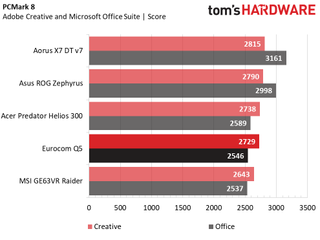
To approximate a system’s common workday performance, we use PCMark 8’s Microsoft Office and Adobe Creative tests. The tasks are platform-based, so systems with powerful CPUs will perform the best.
The Eurocom Q5 lands in fourth place yet again, but the margins between the Q5, Raider, and Helios are rather insignificant; you shouldn’t experience a noticeable performance difference in real world usage. However, the GTX 1080-based laptops perform significantly better, with the Aorus X7 DT v7 in particular outscoring the Q5’s Microsoft Office score by several hundred points, thanks to its i7-7820HK CPU.
MORE: Best Gaming Laptops
MORE: Gaming Laptop Previews
MORE: All Laptop Content
Current page: Synthetic Benchmarks
Prev Page Introduction & Product Tour Next Page Gaming BenchmarksStay On the Cutting Edge: Get the Tom's Hardware Newsletter
Join the experts who read Tom's Hardware for the inside track on enthusiast PC tech news — and have for over 25 years. We'll send breaking news and in-depth reviews of CPUs, GPUs, AI, maker hardware and more straight to your inbox.
-
AgentLozen Enjoyed the review. "... gripping ..." "... powerful."Reply
That Max Q technology makes me a little uncomfortable. It's difficult for me to accept that these otherwise hot video cards are being squeezed into a super tiny form factor. I know its supposed to work out despite what conventional wisdom suggests but if I NEEDED a GTX 1070 laptop, I'd rather it just be bulkier with better cooling.
It's a shame about the screen though. 120Hz is cool but I would like it to be better balanced with image quality. There are good looking TN panel monitors out there. For example, my Dell S2417DG looks good after I calibrated it. I guess Eurocom's TN screen isn't one of those decent ones. I wonder if the IPS option fairs any better. -
Lutfij Nice review but I'm a little worried about the price. Did you contact Eurocom and inform them about the absurdity in their pricing dept?Reply -
almostdecent It is worth mentioning that all Eurocom machines can be configured to taste, so the poor TN display is not an obligatory part of the laptop. I have a Eurocom laptop with a Sharp 4k display that has excellent image quality, with 100% sRGB reproduction and 76% Adobe RGB (according to Spyder calibration)Reply
